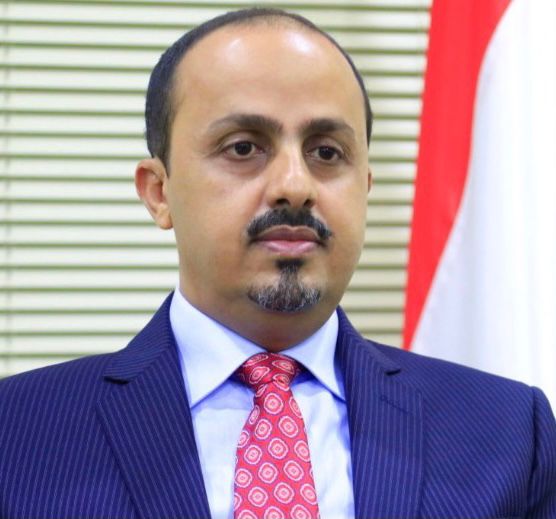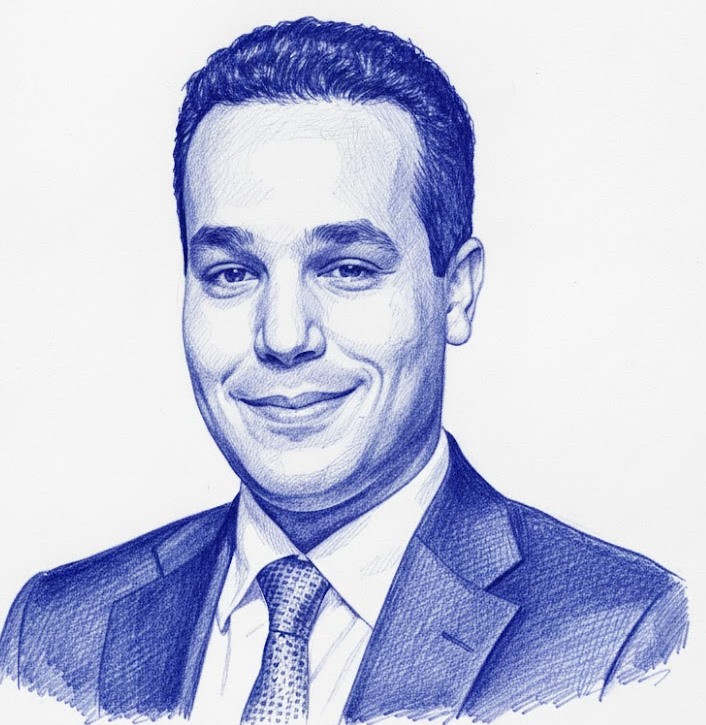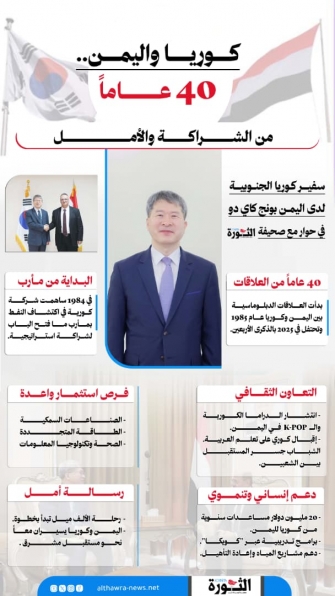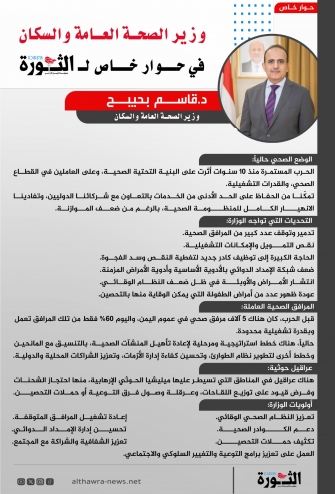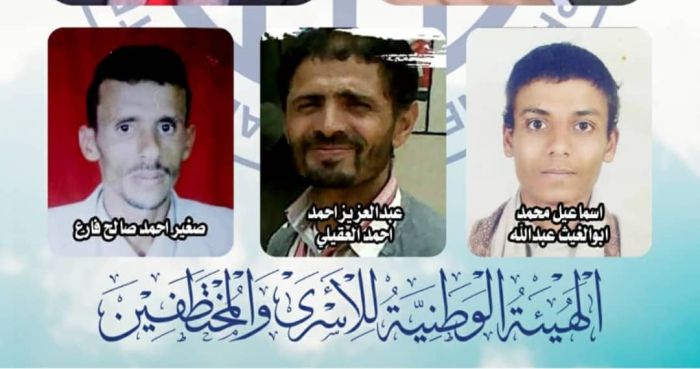عضو مجلس القيادة الرئاسي المحرّمي يُعزّي في وفاة السفير محمد العبادي
![]() رئيس مجلس القيادة يهنئ بذكرى استقلال كازاخستان
رئيس مجلس القيادة يهنئ بذكرى استقلال كازاخستان
![]() رئيس مجلس القيادة يهنئ بذكرى يوم الجمهورية في النيجر
رئيس مجلس القيادة يهنئ بذكرى يوم الجمهورية في النيجر
![]() مصلحة الجمارك تشارك في الاجتماع الـ 17 للجنة الفنية لقواعد المنشأ العربية في القاهرة
مصلحة الجمارك تشارك في الاجتماع الـ 17 للجنة الفنية لقواعد المنشأ العربية في القاهرة
![]() الخطوط الجوية اليمنية تعلن استئناف تشغيل رحلاتها من عدن إلى أبوظبي
الخطوط الجوية اليمنية تعلن استئناف تشغيل رحلاتها من عدن إلى أبوظبي
![]() تقرير حقوقي: 312 حالة اعتقال واخفاء قسري بحضرموت على يد المجلس الانتقالي
تقرير حقوقي: 312 حالة اعتقال واخفاء قسري بحضرموت على يد المجلس الانتقالي
![]() تشييع رسمي وشعبي بمأرب لعدد من شهداء الواجب بالمنطقة العسكرية الأولى
تشييع رسمي وشعبي بمأرب لعدد من شهداء الواجب بالمنطقة العسكرية الأولى
![]() اختتام دورة تدريبية حول الأرشفة الإلكترونية لوقائع السجل المدني بعدن
اختتام دورة تدريبية حول الأرشفة الإلكترونية لوقائع السجل المدني بعدن
![]() ضبط أحد مروّجي المواد المخدرة في الغيضة
ضبط أحد مروّجي المواد المخدرة في الغيضة
![]() أمنية تعز" تُدين جريمة تفجير عبوة ناسفة بحي الضربة بشارع جمال
أمنية تعز" تُدين جريمة تفجير عبوة ناسفة بحي الضربة بشارع جمال


A report published by Al-Manar TV, affiliated with the Lebanese Hezbollah, Iran’s arm in Lebanon, on March 5, 2015 reveals an early relationship between the Houthis and Al-Qaeda, which began with the first steps of Hussein Al-Houthi’s establishment of his terrorist movement under Iranian sponsorship at the beginning of this century.
The relationship emerged after the September 11, 2001 bombings of the World Trade Center, when Hussein Badr al-Deen al-Houthi showed a biased position to the terrorist al-Qaeda organization, after declaring the international war led by the United States of America against terrorism.
The report titled (Death to America, Death to Israel, Victory to Islam… Ansar Allah) says that in response to US President George W. Bush’s position, who addressed the world saying “either with us or against us” after the September bombings, Hussein al-Houthi said: “We should be in the camp of Islam.” Not in the camp of infidelity."
Hussein al-Houthi found in the international war against al-Qaeda a way to start mobilization and incitement in favor of his terrorist project. According to Al-Manar TV report, after the September bombings, al-Houthi began "organizing gatherings and giving lectures", which was talking about the jihad against the infidels and the United States of America, which he said was occupying Yemen and Islamic countries.
Early Terrorist Tendencies
Hussein al-Houthi’s terrorist tendencies showed early in the eighties of the last century, under the banner of jihad.. According to the testimony of his son-in-law, Abdul Rahim al-Hamran, who spoke to Al-Arabi website - loyal to the Houthis, al-Houthi had always dreamed of participating in the fight alongside Iran in its war against Iraq in 1980. Revealing the unveiling of a visit by Hussein al-Houthi in early 1987 to cleric Omar Abdel Rahman in Cairo.
Omar Abdel Rahman - was one of the clerics in Egypt, and was convicted by the United States of America of being behind the bombing of the World Trade Center in New York on February 26, 1993, and was also convicted of plotting to blow up major landmarks in New York, including the United Nations, where he was sentenced to life imprisonment and died in American prison in February 2017.
According to Al-Hamran’s testimony, Hussein Al-Houthi’s interest to visit Omar Abdul Rahman had goals related to his terrorist tendencies, as he says that “Sheikh Omar Abdul Rahman, the owner of lectures to revive the Absent Duty of Jihad, for which demonstrations took place at Cairo University, and suppressed by the Egyptian authorities.” Which made Hussein al-Houthi travel to Cairo to meet him.
Iran... and the Terrorism Twins
According to analysts, the Houthis and Al-Qaeda were and are still moving in parallel lines to target the structure of the Yemeni state, to bring it down and fall prey to the Iranian regime.
While al-Qaeda was targeting the army with terrorist operations and controls areas in Abyan and other governorates before 2010, the Houthis were waging successive wars against the Yemeni army in northern Yemen, under the religion and jihadism slogans.
According to Yemeni and American intelligence reports, this service and cooperation between the Houthis and Al-Qaeda represents an extension of the Iranian regime's relationship with Al-Qaeda and ISIS within the framework of its project to control the region, after its success in expanding in Iraq, Syria and Lebanon.
The announcement of the US State Department's Rewards for Justice Program on June 23, 2021, about the leader of al-Qaeda in Yemen, Khaled Batarfi, came to unveil the relationship between al-Qaeda and the Houthis in Yemen, who are run from Tehran... revealing that Batarfi is executing the instructions of his leaders who are in Iran.
The US announcement reads as follows: "While its leaders in Al-Qaeda are frolicking in Iran, where they are based, Khaled Al-Batarfi and his followers are implementing the instructions of these leaders to spill the blood of innocent people in Yemen. There is no place for Al-Qaeda traitors in Yemen, now and in the future."
Major Aspects of Servicing
During the past twenty years, several forms of cooperation between the Houthis and al-Qaeda appeared, where they are servicing each other and exchanging roles within the framework of one war to weaken the state, empowering the Iranian project in the region - according to observers.
The two reports of the Security Council Panel of Experts on Yemen for the years 2019 and 2020 talked about cooperation between the Houthis, al-Qaeda and ISIS, which appeared in the form of a prisoner exchange.. The two reports documented two exchanges; The first between the Houthis and al-Qaeda in September 2019; The second is between the Houthis and ISIS in April 2020.
In a statement to the Yemeni news agency, Saba, in August 2020, Information Minister Moammar Al-Eryani revealed that the Houthis carried out five releases of Al-Qaeda terrorist elements during the period from November 2018 to April 2020, and the number of those released was 72 terrorist elements.
In a report issued by the Yemeni embassy in Washington at the end of May 2018, the report spoke of photographic evidence proving the revival of the activities of smuggling networks in Houthi-controlled areas and in those where al-Qaeda is present, including arms smuggling, human trafficking, smuggling of antiquities, alcoholic beverages, medicines and narcotics.
The aspects of cooperation are not limited to the above. The National Army forces published confessions of prisoners of the Houthi militia, during which they confirmed that they were fighting in the ranks of Al-Qaeda before the Houthi militia recruited them to fight in its ranks and being captured on the front lines.
On September 2, 2020, the Media Center of the Yemeni Armed Forces published the confessions of the terrorist Musa Nasser Al-Malhani, who was captured while fighting alongside the Houthi militia in Al-Jouf.
The terrorist Al-Malhani confirmed in his confessions that he was one of the members of Al-Qaeda, and he was recruited by the Houthis.. He emphasized the militia's dependence on many Al-Qaeda members residing in Sana'a to run its headquarters to mobilize fighters.
A National Security report submitted to the UN Security Council this year also documented confessions made by al-Qaeda terrorist judge Ali Muhammad Abdullah Hussein Darama, pseudonym, (Judge Bishr), who was arrested on January 13, 2021 in the Marib Governorate, in which he disclosed many information about coordination between al-Qaeda. and the Houthi militia.
The report revealed that the Houthi intelligence service embraces terrorist elements from the terrorist organizations of ISIS and al-Qaeda of non-Yemeni nationalities who fight against the legitimate forces and secure their presence, movements and participation in the management of combat operations.
The report pointed to the funeral ceremonies organized by the Houthi militia for the bodies of the terrorists Saeed Abdullah Ahmed Al-Khabrani, known as (Abu Hail) and his brother Hamid (Abu Nawaf), who were killed while fighting in the Houthi ranks in mid-August 2020 and broadcast by Al-Masirah the Houthi channel, which confirms that the close relationship and the great prestige enjoyed by the terrorist elements among the Houthi militia.
Upgraded Version
Over the past years, the Houthi militia has emerged as a developed version of terrorist organizations, especially in the methods of carrying out murders and terrorist bombings, methods of obtaining money and followers, building alliances, and managing areas of influence.
While "Al-Qaeda" called itself "Ansar al-Sharia", the Houthi militia called itself "Ansar Allah", and they both seek the same goal. Al-Qaeda aims to establish a so-called "caliphate state", while the Houthis seek to impose a "guardianship system" and to achieve that they raised slogans claiming to fight "America and Israel" and accuse of blasphemy anyone who disagrees with them, and they participated in working to weaken state institutions and the rule of law so that they could expand in the country, and to replace it.
The terrorist Houthi militia has excelled in targeting international interests in Yemen and the region - which are the most important common goals between it and Al-Qaeda - using missiles, bomb-laden drones, booby-trapped boats and Iranian-made naval mines, taking advantage of its control over some Yemeni ports, which no terrorist organization in the world has managed to achieve.
While al-Qaeda manipulates religious beliefs to attract fighters and carry out terrorist operations, the Houthis are imposing their extremist beliefs in society and mobilizing fighters by force of arms and under the name of the “Quranic march,” both of which depend on the recruitment and use of children and women in their terrorist and intelligence operations. In fact, the Houthi militia in this regard, has significantly outperformed al-Qaeda, whether in recruiting thousands of children or kidnapping hundreds of women and forcing them to work for it.
The Houthis have also excelled in ways to obtain revenues and money, while “Al-Qaeda” depends on attacking banks and looting their money, as happened in the cities of Mukalla and Seiyun, the Houthi militia carries out continuous campaigns to impose levies and royalties on merchants, companies and citizens in its areas of control, as well as its control over all funds of the Central Bank in Sana'a and its branches in all the governorates it has reached.
In addition, it has expanded its activities to kidnap foreigners in order to obtain huge funds in hard currency (ransom) in exchange for their release, also, citizens of Arab countries, especially Saudi Arabia, and forcing Yemeni families to pay the "ransom" in exchange for the release of their kidnapped relatives because of their political views, and this method was limited to "Al-Qaeda" and restricted to foreigners only.
In the context of killing foreigners, both the Houthis and Al-Qaeda carried out kidnappings and killings of foreigners, most notably the kidnapping and killing of 7 foreigners in Saada by the Houthis in 2009, as well as the killing of 4 Korean tourists in Shibam Hadramout, in addition to dozens of kidnappings of foreigners committed by both terrorist entities.
Inspirational experience
While the world has been waging a relentless war against terrorism over the past years, and succeeded in weakening it and curtailing its activities, the terrorist Houthi militia was able - thanks to Iranian support - to bypass the global anti-terror radar, thus becoming the first terrorist group in the world to turn against a state and plunder its resources, threaten international interests and push the majority of Yemenis to starvation.
The wars waged by the Houthi militia - which has not yet ended - have killed hundreds of thousands of Yemenis - most of them women and children - and turned millions into displaced people, refugees and migrants inside and outside Yemen, living in extremely difficult humanitarian conditions.
Despite the crimes of the Houthi militia and its bloody nature and its rejection of all international peace efforts, despite the concessions made by the legitimate Yemeni government, the international community still overlooks the danger it poses to Yemenis and the world at large, and thus it is the only terrorist group in the world that has areas of autonomous influence and possesses an arsenal of ballistic missiles and drones.
The Yemeni government has previously warned that the approach taken by the terrorist Houthi militia to overthrow the Yemeni state and use the country's resources in its expansionist wars in light of lax international positions, represents an inspiring experience for other terrorist organizations in the region and the world, and indicates endless dangers to Yemen, the region and international security and peace.


